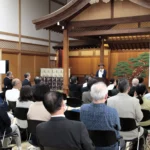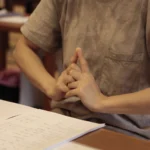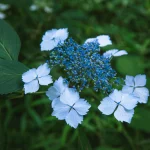Made in Japan
By Bill Roberts
Bill Roberts delivered the following speech to the Kameoka Rotary Club on Aug. 2, 2005.
Konnichiwa. Bill Roberts des. Yoroshiku.
Thank you for asking me to speak today. Three years ago I spoke to the Rotary in Shirotori. It is always a pleasure to address the Rotary.
I have been in Kameoka since October, working on a book about Oomoto, in English for non-Japanese readers. We will publish it by the end of the year, and then I will go home to California.
I live in Silicon Valley where I work as a freelance journalist writing about the electronics industry, which means I mostly write about the semiconductor industry. Silicon Valley is 100 kilometers south of San Francisco.
Silicon Valley is just a nickname for Santa Clara County, which used to have many semiconductor factories. Today most semiconductors are made elsewhere, including the states of Oregon and Arizona, and Japan, Korea and China.
Semiconductors are in everything. They are the building blocks of the 21st century, like concrete and steel were for the 20th century. Here is just one example: Did you know that about one third of the development costs for any new car model are for the electronics in the car?
The number of semiconductors the world uses just keeps growing but as a proportion, very few are made in California anymore.
However, many semiconductor companies still have headquarters in Silicon Valley, where they do research, design and marketing. There is little silicon left in Silicon Valley but it remains the soul of the electronics industry.
You might wonder how I came to write a book about Oomoto. I wonder myself sometimes. So it is good to remind myself by telling you.
I first came to Japan because of Oomoto and the arts.
In 1998 I began to study ceramics as a hobby with Coeleen Kiebert, an artist and teacher in Santa Cruz, California, near my own town. Coeleen had attended Oomoto’s traditional Japanese arts seminar in 1985.
One day Coeleen said she would take some students to Oomoto in the spring of 1999 to study the Japanese arts. She talked about Onisaburo Deguchi and showed us pictures of his tea bowls.
I had never heard of Oomoto. And I had never had much interest in visiting Japan. But I was captivated by the spirit of Onisaburo’s yowan.
I signed up for the trip and by the end of that visit I was enthralled with Japan, especially its scenery, culture and arts. I was also touched by Oomoto’s friendliness and hospitality.
I returned to Japan with Coeleen in 2000 and 2001. Because of my growing interest in Oomoto and my writing skills, Oomoto then invited me to work on several writing projects.
I came as a volunteer in late 2001, in 2002 and in 2003. I wrote stories and took photos for the English section of the Oomoto home page.
Then they commissioned me to write this book, which will include many of my photographs. I have traveled all over Japan to interview Oomoto followers for this book: to Hokkaido, Shikoku, Kyushu and all over Honshu.
Wherever I go, people friendly, the beauty is breathtaking, and the food is usually good. And there is always an onsen nearby. I really like onsen.
After my first trip in 1999, I was surprised at how much I liked Japan. In retrospect I should not have been surprised at all.
You see, my parents met in Japan after World War II. My father was a career Army officer and my mother was a civilian secretary for the Army. They were married in Tokyo in 1947.
They both worked in the occupation government’s natural resources division. When I see Japan’s mountains, streams, forests and farmlands I like to think my parents played a tiny part in helping to rebuild after the war.
My parents loved Japan. They climbed Mount Fuji. They took the boat trip down the Hozugawa. They drove a jeep to Hokkaido, which was not so easy to do in the late 1940s. They had many wonderful experiences they would talk about the rest of their lives.
Some of my earliest childhood memories are pictures they took in Japan. They also had home movies they made in Japan.
Another childhood memory is that phrase: “Made in Japan.” It has an interesting 60 year history from an American perspective.
When I was boy “made in Japan” was a term of derision. It meant cheap but poor quality. The Japanese transistor radio was the butt of many jokes, including a popular song.
When I was a teenager in the late 1960s I heard the Japanese were going to import cars to America. My friends and I laughed. We believed if those cars were no better than the radios we had nothing to worry about. Of course this turned out not to be the case.
“Made in Japan” became a sign of quality. Because of Japanese ingenuity and hard work and the application of various statistical quality methods, “made in Japan” came to represent the highest quality in the world.
I began to understand this around 1971 when I bought my first 35 mm camera, a Pentax. Since then, every camera I owned was made in Japan.
In the early 1980s I was a business editor for the Detroit Free Press, one of the largest daily newspapers in America. Detroit of course is the home of the American auto industry and was one of the newspaper’s biggest stories.
The American auto industry felt threatened by the Japanese auto industry. During my years in Detroit, “made in Japan,” became a phrase of bitter anger, a war cry when the domestic industry fell into a tailspin.
But it was too easy to blame “Made in Japan” for all the woes of American industry. This was xenophobic nonsense.
American industry had gotten lazy and sloppy. As a business editor in Detroit I could certainly see that was the case in the auto industry.
In the late 1980s I became the executive business editor of the San Jose Mercury News. San Jose is the main city in Silicon Valley.
We paid very close attention to all Japanese electronics companies. Many of them have offices in Silicon Valley. Over the years I have met and interviewed several Japanese executives.
By the time I arrived in Silicon Valley in the late 1980s, American business had learned its lesson. We knew that “Made in Japan” meant tough competition in electronics and in everything else. I believe competition is healthy and makes everyone perform better.
Today, of course, made in Japan might mean it is made in China for a Japanese company but that’s a discussion for another time.
You can see that when I came here the first time in 1999 what I mostly knew about your country was Japanese business. I knew little about culture or the arts. I did not know, for example, anything about raku-style tea bowls, which today I make here in Japan.
When I was here for three months in 2001, I learned to make tea bowls in the studio of Kameoka’s Hideki Nishijima. I do not throw on a wheel; I use coils or a pinching method to make the bowls.
Nishijima is a professional potter who fires most of his work in a big gas kiln. Last year he built a charcoal kiln just so he and I could do raku-style tea bowls.
As you may know, raku is only made in Japan, it is one of the few aspects of Japanese ceramics that was not acquired from the Chinese or the Koreans. Raku is authentic Japanese–invented and made in Japan.
I would like to close with this thought.
Today I shoot all my photos with an Olympus digital camera. At home, I own a Honda Accord. Here in Japan I make raku tea bowls.
You could say I really like things made in Japan.
But then I guess that should be expected. You see, I was conceived in Japan in April 1949, three months before my parents returned to the United States.
I was born in America but I was literally “made in Japan.”
Kyo-wa watashino hanashi-o. O-kiki kudasari. Arrigato gozaimashta.



